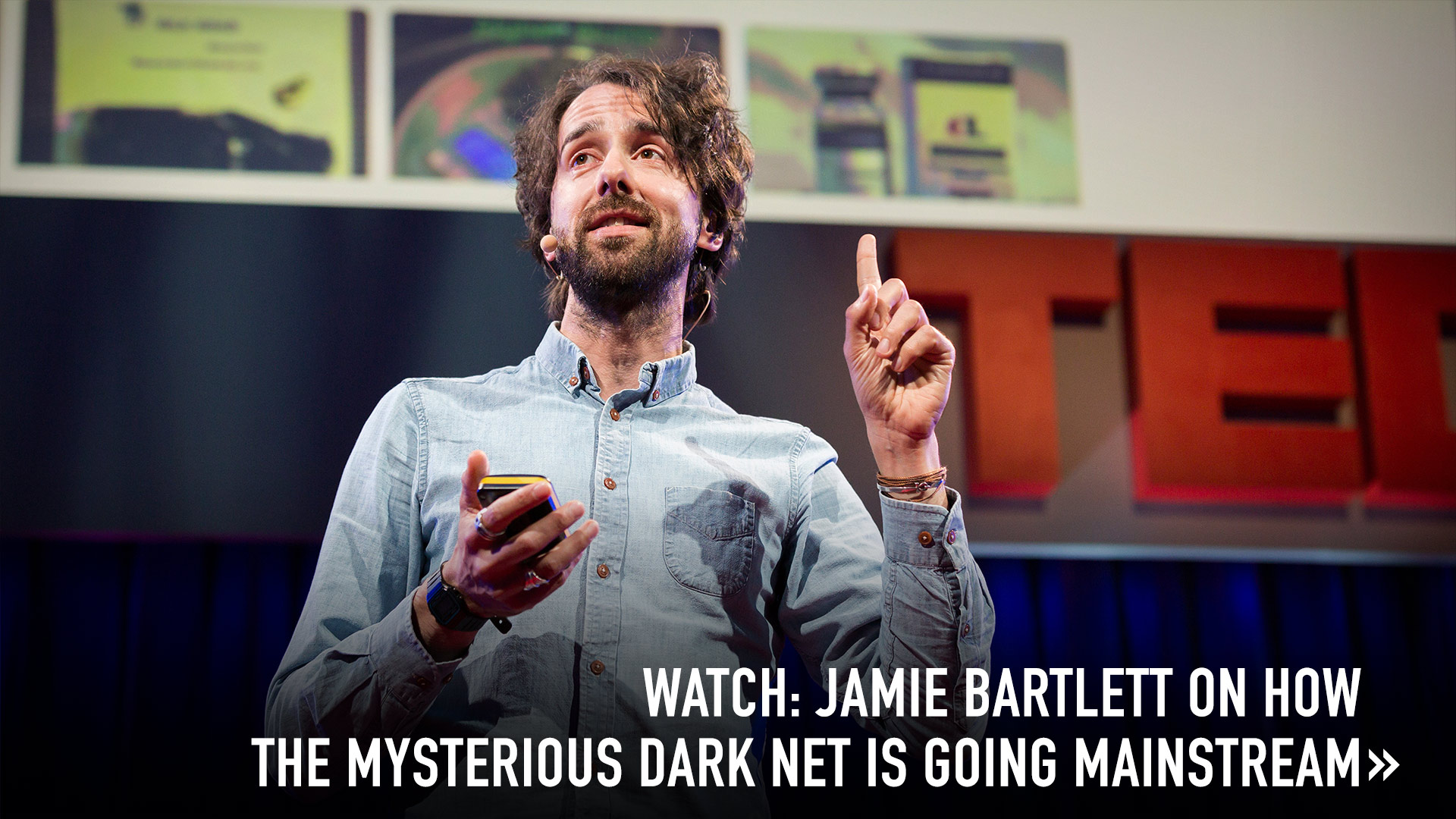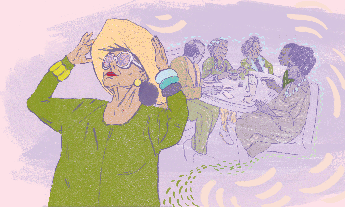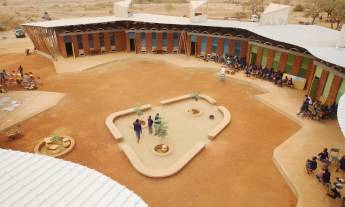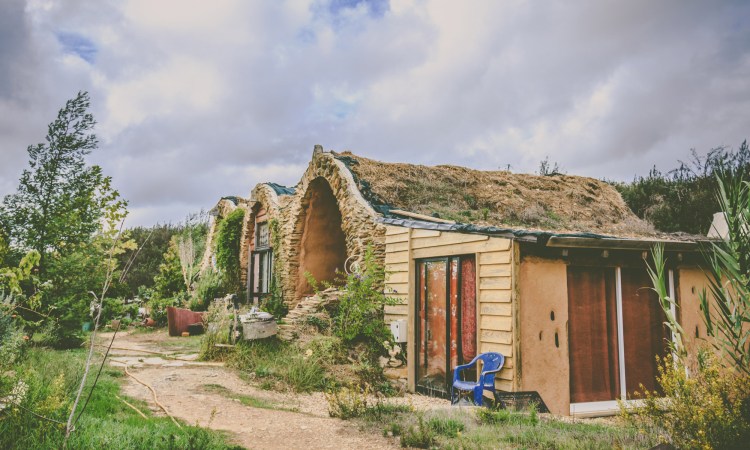
Yes, it has free love, vegan food, Wi-Fi and a low carbon footprint. But it also has unchallenged assumptions, ramshackle housing and a questionable belief system, finds social media analyst Jamie Bartlett.
As the sun rises over the Portuguese countryside, I find myself standing in a circle on top of a hill with a group of strangers, grasping hands, eyes shut. We are gathered around a collection of enormous stones, a candle, a ceramic bowl filled with water, and a crystal. A woman in white robes is humming, and we are trying to stop the war in Syria using our thoughts in an exercise called the Ring of Power.
I’m at the eco-village of Tamera, which is a two-hour train journey from Lisbon. More than 20 years ago, a band of Germans arrived here with little money and an ambitious plan to create what they called a “healing biotope,” a template of how humanity could live in harmony with themselves, their fellow humans and the environment.
The Ring of Power was one of the items on the agenda for the forty of us outsiders. Every several months, Tamera allows visitors to live here for a few days and learn how it works. It cost us €350 each to attend, plus €30 each per day for food and accommodations.
Tamera is split into two sites. On the western side is the Campus, where visitors stay. It has a bar, café, kitchen, eating area, cultural center, bookshop, guest house, male and female dorms and auditorium. On the eastern side are the 150 full-time Tamerians. They reside in small villages of 20 to 30 residents — who range from babies to octogenarians — who inhabit caravans, huts, yurts and shacks. The whole place has the feel of a half-finished holiday campsite.
The visitors are mostly well-off Westerners dissatisfied with what the modern world offers and looking for more meaning. Tamera is the brainchild of psychoanalyst Dieter Duhm. He’d been involved in the 1968 left-wing student movements but was confused by their failure to transform the world. Like other ’68ers, Dieter concluded it wasn’t the material world that needed reshaping, it was the mental one. He came to believe that unresolved sexual desire, jealousy and a lack of trust were the reasons for our problems. Dieter, his partner (and a self-described medium) Sabine Lichtenfels, and a handful of others founded Tamera in 1995.
While many Tamerians have a “primary partner,” nearly everyone has multiple sexual relationships, which they call “love free of fear.”
“We are building a trust-based community,” says Monika, our guide and a senior Tamerian in her early 60s who has lived there since 2000. To that end, Tamerians do not live in nuclear families. Adults live alone or in shared single-sex accommodations. About thirty children live in Tamera, most of them born here. From age four, they live in the Place of the Children, accompanied by an adult (but not always the parent). The children are home-schooled according to the Portuguese curriculum. Although there are a handful of Portuguese and a couple of Brits and Israelis, nearly everyone here is German.
While many Tamerians have a “primary partner,” nearly everyone has multiple sexual relationships. They call this “love free of fear.” Free love and transparency are, Monika says, key to the community’s survival and help create trust, which is also achieved through daily forums. There, Tamerians sit in a circle with a leader. One person stands in the middle and says what’s on their mind, and the others then say what they think in return.
“I have only thirty euros in the bank. Either I’m extremely poor, or I live in paradise,” says one Tamerian.
Tamera is part of a movement of communities that call themselves eco-villages. Eco-villages are typically made up of between 50 and 150 people who try to live together in an environmentally, socially and economically sustainable way. According to the Intentional Community Directory, there are 2,255 eco-village communities in 70 countries, from a network of remote villages in Sri Lanka to the popular Cristiana in Copenhagen, an autonomous commune of 850 people. Uncertain times often stimulate movements like this, and more than 300 new eco-villages were founded in the first ten months of 2016.
It’s difficult for a commune to reach full autonomy, however. Intentional community-building takes a lot of work, including technical know-how. Douglas Baillie, a polymath in his early forties, used to be an optical physicist in the UK. But he was increasingly worried about the environment and after a couple of years of visiting Tamera to offer technical advice, he moved there full-time. One of their chief engineers, he lives in the Solar Village with his two children and thirty other residents. “Now I have only thirty euros in the bank. Either I’m extremely poor, or I live in paradise,” he says as he shows us the village.
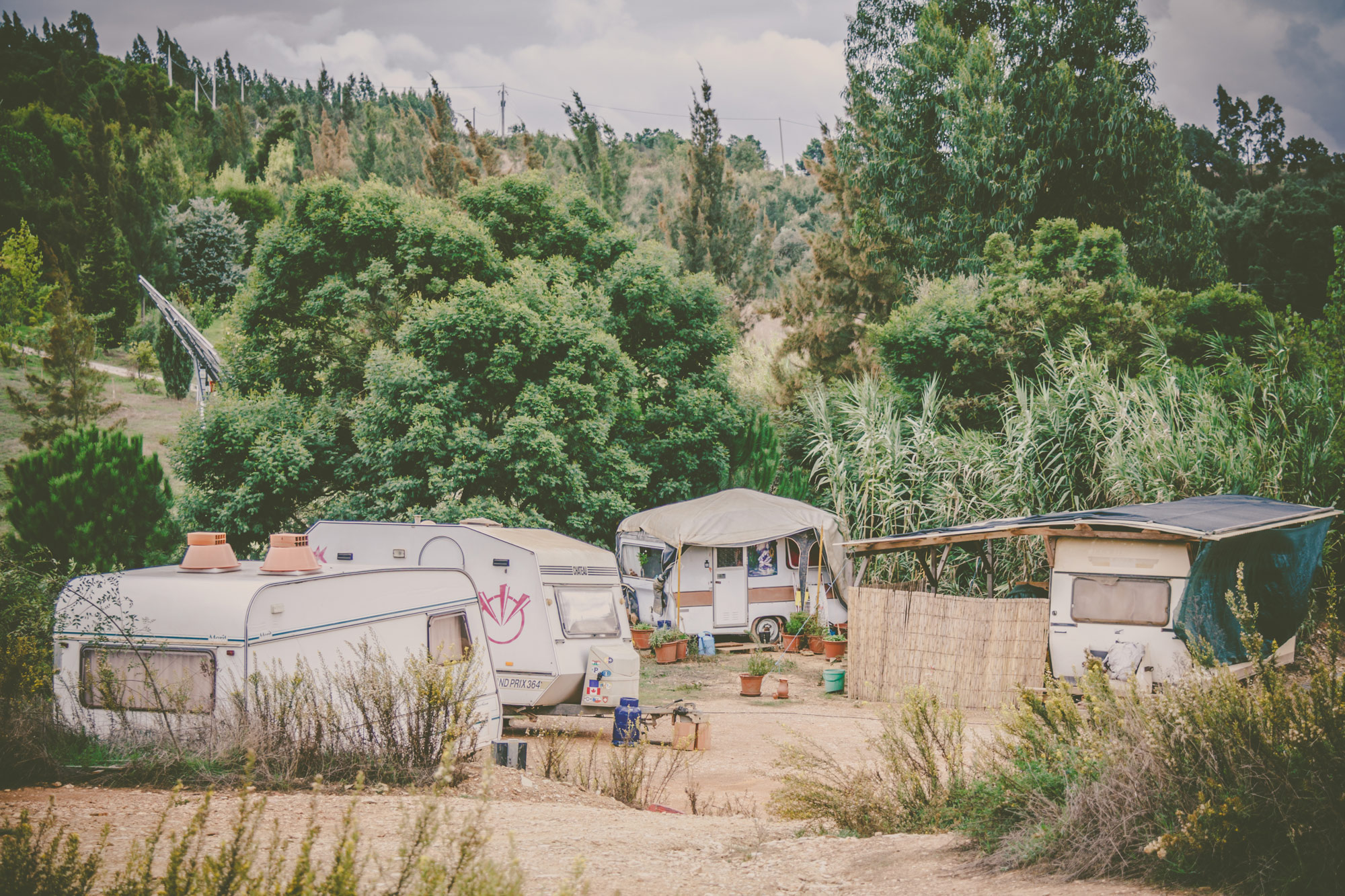
It’s a collection of caravans and shacks that surround an open-air kitchen, a seating area and a couple of workshops full of machinery and tools, where Douglas and others research how Tamera can become self-sufficient in energy, food and water. Its kitchen contains a Scheffler mirror, a fixed-focus reflector that captures sunlight and reflects it onto a smaller mirror, which in turn reflects it onto a stone that heats under the pots and pans. The mirror moves automatically to follow the sun with a mechanism built from bicycle parts. During sunny summers, it works as well as a conventional gas stove. On overcast days, the kitchen runs on biogas generated by kitchen waste.
Douglas also works with a German inventor called Jürgen Kleinwachter, who created the Energy Power Greenhouse (EPG). The EPG uses special lenses to heat vegetable oil in pipes in the village’s greenhouse. The hot oil is piped into an engine to heat air. When air is heated, it expands and the expansion moves a piston, which creates mechanical energy that is turned into electricity. The vegetable oil is then piped to the kitchen to warm water, before going to the greenhouse to be reheated. There are no emissions; the oil endlessly flows, transporting heat. “It’s a different way of thinking,” says Douglas. “We’re part of a cycle.”
Tamera’s water-retention efforts are similarly impressive. Southern Portugal is extremely arid, but there is plenty of water in Tamera. Residents have worked with a permaculturalist to develop landscapes that keep rainwater in the ground through strategically placed lakes, ponds, wells and water terraces. The soil has become more abundant, vegetation is growing, and the wildlife is more varied than in surrounding areas. An EU study of Tamera found that benefits included increased carbon storage, improved water quality and stabilization of the groundwater table.
Tamera is a confusing place: part ridiculous, part slightly worrying and part hugely impressive.
Jules, a consultant from the UK who describes himself as a “spiritual hippie,” tells me he’s heard that at 7:15 AM Tuesday through Saturday, Dieter or Sabine hold a seminar called God Point for Tamerians. When Jules and I show up for it, we find 30 members assembled. A translator is located for the two of us. Dieter, in tracksuit bottoms, a beanie and Crocs, is at the front next to Monika. The wooden floor and walls, twinned with German voices, give the meeting a Lutheran quality. But then Monika plays “The Gambler” by Kenny Rogers as a welcome. And it’s not the Bible she reads from; it’s passages from Dieter’s book The Gospel Then and Now: Thoughts from the Sea of Galilee.
Dieter discusses the passages, which touch on his core philosophy. Tamera isn’t just about creating an autonomous, sustainable community. There is, he says, a “deep” structure of reality beyond the superficial one we see. That reality can be accessed if we awaken our consciousness through spiritual thought, meditation and “meaningful encounters.” By doing this, we can tune in to the “morphogenetic field” created by collective human thoughts and behaviors.
According to Dieter, the planet’s morphogenetic field is currently trapped in violence towards men, women, children and nature. But it can be changed. The ultimate purpose of Tamera, he explains, is to create new information and thoughts that can be sent out into the morphogenetic field and tip it onto a more peaceful setting. “We can move mountains with this power!” says Dieter, in a warm, baritone voice.
However, Dieter’s promise of accessing a deeper reality and affecting the universal consciousness is standard fare — Deepak Chopra has written dozens of books that say essentially the same thing. Dieter’s books include statements like ”Being seen means being loved” and “My circumference and the circumference of the universe are identical.” The notion that his circumference is the same size as the entire universe’s is nonsense. But it’s nonsense that is easily mistaken for profundity.
Issues of control and coercion lie at the heart of any form of communal living. Who is in charge? What power do they have over other members? Although Tamera claims to have escaped dogmatic Western rationalism and skepticism, the founders and the residents have created their own unchallengeable assumptions. Dieter’s quotes are pinned on the walls and painted on murals, and younger Tamerians repeat his lines and metaphors with little deviation. It is assumed to be true, for example, that bringing children up in a commune-like environment is better, although most child psychologists would disagree. It is taken as obvious that free love is better for one’s well-being, despite there being no evidence to show that the denial of free love adversely affects mental or physical health.
Even though there is some inequality at Tamera, it does feel like everyone is in it together.
Tamera is a confusing place: part ridiculous, part slightly worrying and part hugely impressive. When I ask to see how Tamerians actually live, Monika agrees to give me a tour of the entire place. “Our applications for building permission are stuck with the authorities,” she says, as we walk through constellations of shacks and caravans. “Therefore we still have to live very temporarily.”
People have few possessions: some have battered TV sets, a few books and secondhand clothes. The typical day often starts with some form of meditation or God Point and then, depending on the role, it’s on to the day job. Monika shows me the pottery and sewing workshops. In the Institute for Global Peace, which looks like a tech startup office, half a dozen faces are squinting into laptops, replying to emails, redesigning the eco-village’s website, etc.
Since the 1970s, the failure of communes has been the subject of academic study. Many collapse at the first sign of difficulty. Those governed by rigid social hierarchies are often embroiled in sex scandals or accusations of misconduct, while egalitarian communes can result in a degeneration of interpersonal relationships.
Yet Tamera hasn’t failed. While the founders are still sources of the vision, much of the daily business has been handed to a younger generation. No one is here against their will; every Tamerian seems thrilled to be part of this project. Even former Tamerians — and dozens have left over the years for various reasons — who spoke to me didn’t have anything bad to say. It’s hard not to admire their dedication, openness and optimism. In return, residents get simplicity, sustainability and community. Even though there is some inequality — Dieter’s house is nicer than the rest — it does feel like everyone is in it together.
But Tamera hasn’t succeeded, either. Monika tells me Tamera’s spiritual attention is homed in on being more “embedded” in Portugal, which she thinks will help them receive building permission from the authorities. The eco-village’s population can’t grow without such permission, and currently it depends on the outside world. About half their energy — for lights, heat, power for the Wi-Fi, refrigeration and so on — is generated by the Solar Village and solar panels; the rest comes from the national grid. They grow 25 percent of what they eat and buy the rest from local farmers (Tamera is a vegan community). Approximately half their income comes from visitors like me. In the winter, some Tamerians go into the real world to earn money to plough back into the project. They’re not aiming at complete autonomy — they want to remain connected to the outside — but Monika says if Tamera is to become sufficiently complex and comprehensive to change the morphogenetic field, it needs to grow to about 500 people.
But some studies have found that tight-knit communities rarely grow to that size because there is a brain (and time) limit on how many relationships humans can maintain. This theory has been called Dunbar’s Number, after Robin Dunbar (TEDxObserver Talk: Can the Internet buy you more friends?), an Oxford anthropologist who calculated this cap to be around 150 people, which is the size of Tamera.
I have a feeling that, like many utopian dreams, Tamera is trapped, destined to forever strive but never arrive. Of course, that’s part of the appeal: to be in a perpetual state of happy struggle, with the end always just over the next hill. Perhaps if Tamerians were able to properly test Dieter’s theory of changing the world, it might fail. Better it stays stuck between failure and success, a small beacon and a warning for those from the outside who look at the modern world and wonder: Can’t we do something better than this?
Excerpted with permission from the new book Radicals Chasing Utopia: Inside the Rogue Movements Trying to Change the World by Jamie Bartlett. Copyright © 2017. Published by Nation Books, an imprint of Perseus Books, LLC, a subsidiary of Hachette Book Group, Inc.

